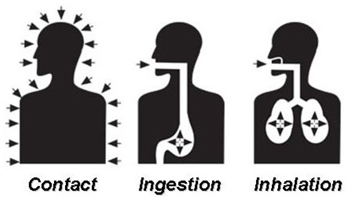Protecting Human Health
Most chemicals used to protect wood from insects and decay are toxic. Reduce risks of exposure by selecting products and application methods that will control the pests without harming the applicator, the user, the public, or the environment. Ensure that the proper handling procedures, protective clothing, and any necessary equipment (such as respirators) are supplied to workers according to label instructions.
The EPA-approved label is the primary source of information on application methods, precautionary measures for workers, emergency first aid for high-level exposures, and disposal instructions for used pesticide materials and containers. The label has the force of law. Its provisions are enforced by the Kentucky Department of Agriculture. The label and Safety Product Data Sheet for each product used at a wood treatment operation should be readily available and all responsible personnel should be familiar with its contents.
Hazards to Applicators
Everyone who handles wood preservatives needs to know the risks in working with them and the necessary precautions to minimize these risks. Most of the risk associated with wood preservatives comes from personal exposure during their application process. Commonly used wood preservatives are toxic. Some can irritate and burn the skin, eyes, nose and throat and cause dizziness and muscle spasms. Excessive contact, particularly with some concentrates, can cause short-term, long-term, or permanently damaging effects.

Wood preservatives, like other pesticides, can enter the body in three ways:
- Contact (skin)
- Ingestion (oral)
- Inhalation (respiratory)
In many cases, wood preservatives are received, transferred, mixed, stored and applied in closed systems. However, occasional leaks can present sources of human exposure. Handling of freshly treated wood is highly mechanized; thus, potential dermal exposure of employees is usually minimal except for maintenance and cleanup jobs. Many wood preservatives have a strong odor and taste, so it is very unlikely that a person would swallow a dangerous amount. Constant, careless and accidental dermal or respiratory exposure, however, can cause short or even long-term health effects.
Exposure to wood preservatives can occur while handling and mixing the chemicals, entering pressure-treatment cylinders, working around spray or dip operations, handling freshly treated wood, cleaning/servicing equipment, or disposing of wastes. Closed systems for handling the chemicals and mechanical handling of treated wood helps to reduce potential exposure but does not eliminate the possibility of some routine or accidental exposure for workers.
Because of the potential hazard of these preservatives, there are EPA label requirements for their handling and use. In addition to the potential hazards of chronic toxicity, a single or short-term exposure may cause acute health effects such as:
- Eye irritation, irreversible eye damage
- Allergy or asthma symptoms or breathing difficulties if inhaled
- Mild skin irritation, allergic skin reaction, or skin burns
- Respiratory irritation.
[return]
First Aid
Since accidents do happen, first aid information on the chemical(s) in use must be readily available. The product label gives basic first aid directions, as do the Product Safety Data Sheets supplied by chemical manufacturers.
The following general steps apply to accidental exposure to wood preservatives:
•Skin contact
First remove contaminated clothing in contact with the skin. Immediately wash the affected areas with mild soap and water. Do not irritate the skin by scrubbing. Consult a doctor if you notice inflamed skin, redness or itching in the affected area.
•Eye contact
Immediately flush the eyes with running water. Lift the upper and lower eyelids for complete irrigation and continue for 15 minutes, then see a doctor.
•Inhalation
Move the victim to fresh air and apply artificial respiration as needed. Get medical help immediately.
•Ingestion
If chemical preservative has been swallowed, call medical help immediately. Only induce vomiting if the label first aid calls for it. Follow the instructions and get medical help immediately. Never attempt to give anything by mouth to an unconscious person. Never induce vomiting in an unconscious person.
[return]
Protecting the Applicator
Basic, common-sense hygiene rules can significantly reduce risks of chronic exposure to wood preservatives.
- Don't eat, drink or smoke in the work area; worker's hands can transmit residues to whatever they touch.
- Wash hands often, especially before using the restroom, smoking or eating.
- Remove gloves to handle paperwork, phones or equipment that others may handle with unprotected hands.
- At commercial treatment plants, protective clothing must be left at the plant. If work clothes must be washed at home, keep them separate from other laundry.
- Protective clothing requirements are specified on the label. These include the use of impermeable gloves for applying the preservatives and in all situations where skin contact is expected (e.g. handling freshly treated wood and manually opening pressure treatment cylinders). In certain situations such as spraying the chemicals and working around pressure treatment equipment, additional clothing may be required. Such clothing may include overalls, jackets, boots, respirators (properly fitting and maintained, approved by MSHA/NIOSH) goggles and head covering.
- Individuals who enter pressure treatment cylinders and other related equipment that is contaminated with the wood treatment solution (such as cylinders that are in operation or are not free of the solution) must wear protective clothing, including overalls, jacket, gloves, and boots impervious to the wood treatment solution, and a respirator.
Work Practices and Protective Clothing
Protective clothing requirements will be specified on the product label attached to the container. It is imperative that the label requirements on these preservatives be strictly adhered to.
Posting Documentation and Technical Data
Certain documentation is available on site when wood treating chemicals are used, such as:
•Material Safety Data Sheets (MSDS), available for each treating compound as shown in included examples.
•Technical data sheets, available from manufacturer and/or vendor.
•Toxicity data, available from the manufacturer.
[return]


